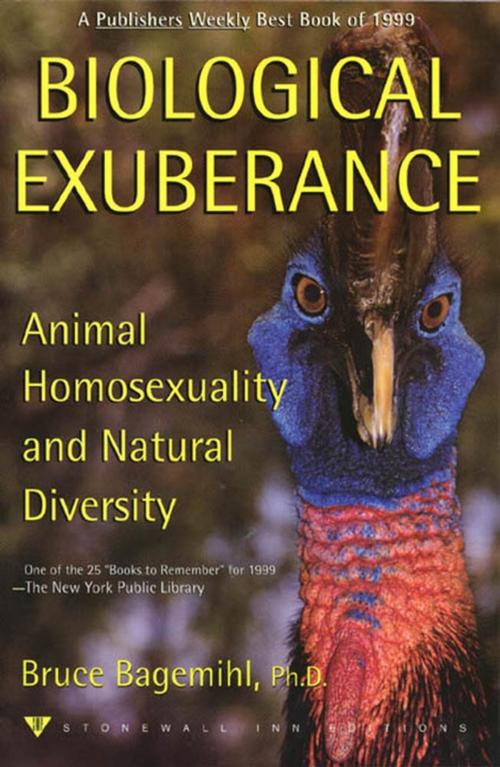Biological Exuberance
Animal Homosexuality and Natural Diversity
Nonfiction, Social & Cultural Studies, Social Science, Gender Studies, Gay Studies, Science & Nature, Science, Biological Sciences| Author: | Bruce Bagemihl | ISBN: | 9781466809277 |
| Publisher: | St. Martin's Press | Publication: | April 10, 2000 |
| Imprint: | St. Martin's Press | Language: | English |
| Author: | Bruce Bagemihl |
| ISBN: | 9781466809277 |
| Publisher: | St. Martin's Press |
| Publication: | April 10, 2000 |
| Imprint: | St. Martin's Press |
| Language: | English |
A Publishers Weekly Best Book
One of the New York Public Library's "25 Books to Remember" for 1999
Homosexuality in its myriad forms has been scientifically documented in more than 450 species of mammals, birds, reptiles, insects, and other animals worldwide. Biological Exuberance is the first comprehensive account of the subject, bringing together accurate, accessible, and nonsensationalized information. Drawing upon a rich body of zoological research spanning more than two centuries, Bruce Bagemihl shows that animals engage in all types of nonreproductive sexual behavior. Sexual and gender expression in the animal world displays exuberant variety, including same-sex courtship, pair-bonding, sex, and co-parenting—even instances of lifelong homosexual bonding in species that do not have lifelong heterosexual bonding.
Part 1, "A Polysexual, Polygendered World," begins with a survey of homosexuality, transgender, and nonreproductive heterosexuality in animals and then delves into the broader implications of these findings, including a valuable perspective on human diversity. Bagemihl also examines the hidden assumptions behind the way biologists look at natural systems and suggests a fresh perspective based on the synthesis of contemporary scientific insights with traditional knowledge from indigenous cultures.
Part 2, "A Wondrous Bestiary," profiles more than 190 species in which scientific observers have noted homosexual or transgender behavior. Each profile is a verbal and visual "snapshot" of one or more closely related bird or mammal species, containing all the documentation required to support the author's often controversial conclusions.
Lavishly illustrated and meticulously researched, filled with fascinating facts and astonishing descriptions of animal behavior, Biological Exuberance is a landmark book that will change forever how we look at nature.
A Publishers Weekly Best Book
One of the New York Public Library's "25 Books to Remember" for 1999
Homosexuality in its myriad forms has been scientifically documented in more than 450 species of mammals, birds, reptiles, insects, and other animals worldwide. Biological Exuberance is the first comprehensive account of the subject, bringing together accurate, accessible, and nonsensationalized information. Drawing upon a rich body of zoological research spanning more than two centuries, Bruce Bagemihl shows that animals engage in all types of nonreproductive sexual behavior. Sexual and gender expression in the animal world displays exuberant variety, including same-sex courtship, pair-bonding, sex, and co-parenting—even instances of lifelong homosexual bonding in species that do not have lifelong heterosexual bonding.
Part 1, "A Polysexual, Polygendered World," begins with a survey of homosexuality, transgender, and nonreproductive heterosexuality in animals and then delves into the broader implications of these findings, including a valuable perspective on human diversity. Bagemihl also examines the hidden assumptions behind the way biologists look at natural systems and suggests a fresh perspective based on the synthesis of contemporary scientific insights with traditional knowledge from indigenous cultures.
Part 2, "A Wondrous Bestiary," profiles more than 190 species in which scientific observers have noted homosexual or transgender behavior. Each profile is a verbal and visual "snapshot" of one or more closely related bird or mammal species, containing all the documentation required to support the author's often controversial conclusions.
Lavishly illustrated and meticulously researched, filled with fascinating facts and astonishing descriptions of animal behavior, Biological Exuberance is a landmark book that will change forever how we look at nature.















